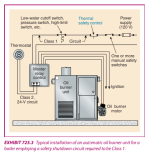pipe_bender
Senior Member
- Location
- Boston
- Occupation
- Electrician
This is what I got:
"Remote-control circuits for a oil burner safety-control switch are classified as a Class 1 Safety-Control since the failure of the switch to operate introduces a direct fire or life hazard.
As covered in 527 CMR 12.00 Massachusetts Electrical Code (Effective 2/17/23) NFPA 70 NEC Section 724.31, all conductors of such remote-control circuits shall be installed in Type MC cable or one of the other wiring methods listed in 724.31, NM cable is not suitable for this purpose".
"Remote-control circuits for a oil burner safety-control switch are classified as a Class 1 Safety-Control since the failure of the switch to operate introduces a direct fire or life hazard.
As covered in 527 CMR 12.00 Massachusetts Electrical Code (Effective 2/17/23) NFPA 70 NEC Section 724.31, all conductors of such remote-control circuits shall be installed in Type MC cable or one of the other wiring methods listed in 724.31, NM cable is not suitable for this purpose".


